Great writing can be the difference between affiliate marketing mediocrity and affiliate marketing rockstardom. For nearly a decade, I’ve followed 10 simple writing rules. These rules have helped me to make millions of dollars online. And since they are universal rules, they will work for you too.
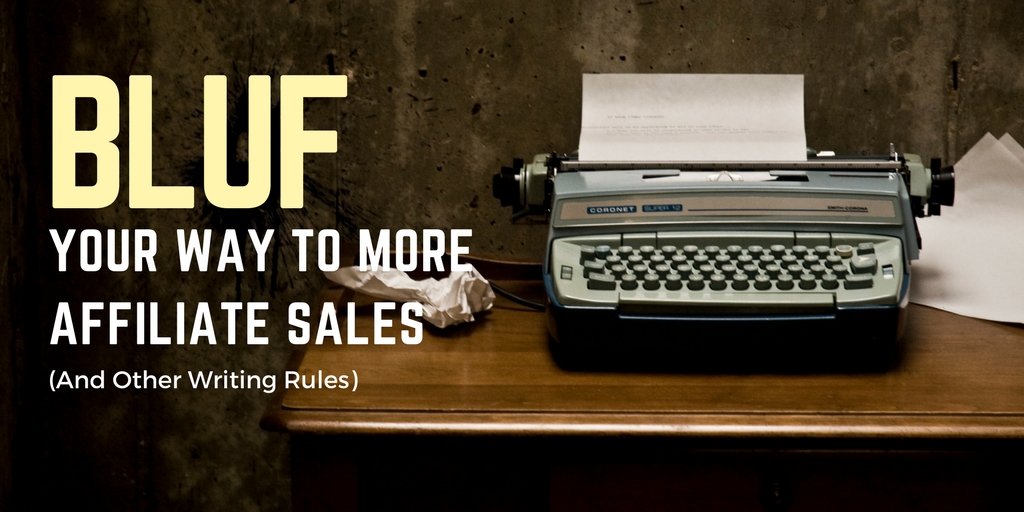
This post originally appeared on this blog in March 2017. Updates have been made to make it even more awesome than before!
Affiliate marketing is all about communication. If you communicate well, your audience trusts you, which means more sales. If you communicate well, your audience is compelled to buy, which means more sales. If you communicate…well, you get the point.
Every time I write something, be it a blog post, sales copy, or an email to my list, I refer back to my “10 Rules for Writing” cheat sheet. This cheat sheet contains my 10 rules for compelling communication.
I’ve used these rules for nearly a decade now and they work for everything you could ever write.
- Blog posts
- Email copy
- Squeeze pages
- Sales pages
- One-on-one emails
- Literally anything…
I share the 10 rules below in detail, but if you want a printable cheat sheet version, click here to download one.
Here are my 10 rules in detail:
1. BLUF
BLUF stands for “Bottom Line Up Front.” It’s a military term that means “get to the point.”
In the news world, they say “don’t bury the lead.”
We’ve all received emails that read something like this…
So, I was cooking dinner the other day. A bunch of friends were coming over and blah blah blah.
As I was cooking, I was thinking about my life. And so on and so on.
Anyway, that got me thinking that…etc. etc.
Can you babysit my kids next Tuesday from 6-9?
It takes 14 paragraphs to get to the lead. It’s buried underneath a mound of irrelevant information.
In the affiliate marketing world, such an email might look like this:
I’m a big fan of running. Last year I ran three marathons.
I started running when I was 12 years old…
Today, I run an average of 30 miles per week. I love the feeling of the wind on my face…and on and on.
After years of searching, I found the perfect guide for beginning runners.
THAT is the lead! Don’t bury it. Lead with it!
Share the best part first and then give them a reason to keep on reading.
When writing, don’t bury the lead. Share the best part first and then give them a reason to keep on reading.
2. Start with a BIG Promise
Somewhere in your first paragraph, you want to make a big promise.
Consider the first paragraph of this post:
These rules have helped me to make millions of dollars online. And since they are universal rules, they will work for you too.
That’s a BIG promise!
Here are some other examples I found from recent emails and posts of mine:
“Anyone can run a 7-figure affiliate program in any industry, even if you know absolutely no one.”
“You can more than double your affiliate sales with a great bonus package. One hour of planning is all it takes.”
“When you learn this one skill, you can cut your workload by as much as 20%. That’s a savings of 8+ hours for most of us. Imagine what you could do with those 8+ hours.”
When you start with a BIG promise, you do three things:
- Catch the reader’s attention. “Wow! That’s a bold statement.”
- Get people thinking of what is possible. “I never thought I could do that…but what if?”
- Arouse curiosity. “How is this possible? I must read on.”
That gets them in the right mindset and keeps them reading.
3. Be Original and Use Energetic Language
Don’t use tired language, clichés, or common figures of speech.
Your choice of words should exude energy and avoid boring, stuffy clichés.
4. Tell a story
One great way to use original and energetic language is to tell a story.
When you tell your story, your language becomes original and energetic almost by default. No one can tell your story like you can. And think about when you tell a story of your own to others…you naturally get excited and that energy is transferred into the words you use.
Here’s the “formula” that works best (but be careful not to always use this formula or it becomes tired and boring):
Here’s where I was (Struggle) >>
Here’s where I am now (Success / Open Loop) >>
Here’s how I got there (Guide / Solution)
Within that, there is a more detailed framework that I often follow. I got it from Don Miller, who runs a workshop called StoryBrand.
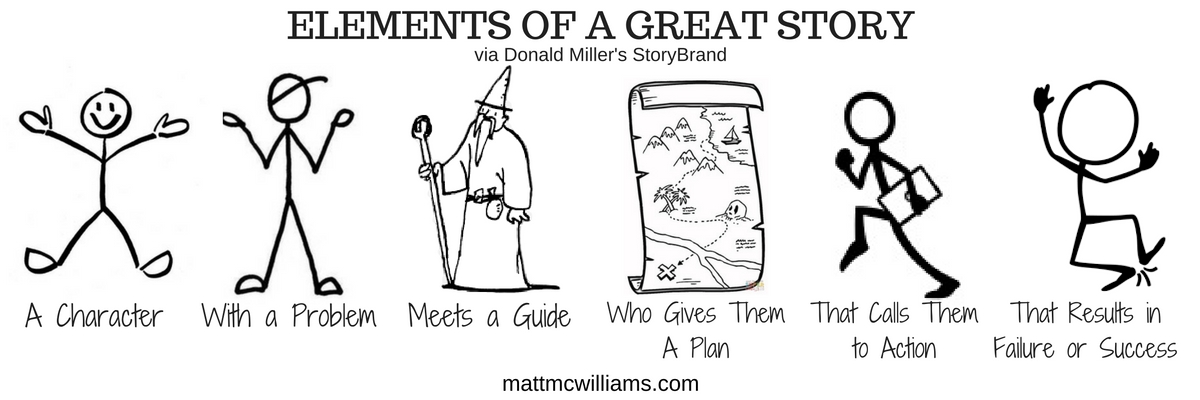
So, what might that look like? Here’s a very quick (and therefore undetailed) version promoting Ray Edwards’ Copywriting Academy, for example:
Three years I was ready to give up on my online business.
I could not sell anything. My copywriting was absolutely terrible.
Now, today I run a successful, multi-six-figure business. I enjoy the freedom, flexibility, and fruits of a lifestyle business.
How’d I get to this point? Well, I’ll share more about that a moment.
But first, let me take you back to three years ago.
That’s when I met Ray Edwards.
I went to one of his webinars where he showed me his 3-part framework for great copy.
And he challenged me to put what I’d learned to immediate use.
And I did…that day I sent an email to my list using what I’d learned.
And the results?
My single best open rate and click through rate in the history of my business!
Now, to be clear, that is a very rudimentary look at what I’d write. But you get the idea.
Follow that formula…it works every time!
5. Paint a Vivid Picture
Your words should spark creative thoughts in the minds of your readers. They should feel like they are in the story.
What I clearly did not do in my example above is paint a vivid picture of any of the steps. a vivid picture of where I was would include details like:
- The anxiety I felt with a new baby and a failing business.
- The sleepless nights.
- The stress on my marriage.
- How I felt like a failure.
You want the reader to be able to relate and that can only happen if you make them feel like they are a part of the story. Draw them in with vivid portraits and details of your experience.
You also want to paint a vivid picture of what success looks like for them. Don’t just say “You’ll have more time off.” Say “You’ll have more time to enjoy the things that you love, more time with your family, more time to invest in your health” etc.
6. Use Small, Simple Words
Don’t make people have to whip out their dictionary.
Think like a caveman (best read using your internal caveman voice). “Me like Joe. You buy course.”
OK, not that simple, but you want to write at approximately a 6th grade level. You are writing to be understood, not to impress your 12th grade English teacher.
I don’t know about you, but when I was in high school, the best way to guarantee a good grade on an English paper was to not understand it myself. I used a lot of words whose definitions I still don’t know. That was great for Mrs. Sisson, but not for growing an email list or selling affiliate offers.
Here’s a rule to follow: Anytime you come across a word with more than four syllables, ask yourself, “Is there a simpler word I could use here?”
Anytime you use a word with more than 4 syllables, ask yourself if there is a simpler word.
7. Use Short Sentences and Paragraphs
When you are writing to be understood and call people to action, keep your sentences and paragraphs short.
Your objective is to move them along, from beginning to call to action. You want to give people a sense of progress. If it takes a person two minutes to get through the first paragraph, that won’t happen.
As a general rule, sentences should be less than twenty words. Paragraphs should be four sentences or less. Avoid large blocks of text that look intimidating.
Look for ways to break up long sentences. Here’s an example from the paragraph above:
As a general rule, sentences should be less than twenty words. Paragraphs should be four sentences or less.
When I originally wrote that sentence it was:
As a general rule, sentences should be less than twenty words and paragraphs should be four sentences or less.
It’s a very subtle change, but breaking that up into two sentences makes it easier to read.
(Side note: That previous sentence originally read “…into two sentences improved the readability dramatically.” But I followed rule #6 and used shorter, simpler words.)
8. If You Can Eliminate a Word, Do It
I used to write for a local newspaper in my early twenties. I’m so thankful for that time because it taught me how to really edit.
I had a limit of 750 words and usually, my first draft clocked in somewhere around 800-850 words. That’s when the tough work began.
This process taught me to refine my thinking. It taught me to say things in a simpler way. And it taught me how to eliminate fluff.
Here’s an example I found from one of my articles back in 2003:
As I was thinking about the current state of affairs in Washington, I was reminded of a scene in Monty Python and the Holy Grail.
25 words with 129 characters. It’s also written in the passive voice (see rule #10) which is bad.
In my first edit, that sentence became:
The current situation in Washington reminds me of a scene from Monty Python and the Holy Grail.
Boom! 17 words and 95 characters.
It’s not only shorter, but it’s clearer and more powerful. Both sentences are grammatically correct, but the second one is easier to read.
Recommended Programs: Click Here to see all of our recommended affiliate programs.
9. Don’t Use Jargon
This is especially important for internet marketers and niche marketers to keep in mind. It’s easy to slip into using “techie” language or “industry-specific” terms.
Just remember that if you are writing to a broad audience or to newbies to your industry, you need to avoid jargon.
There is no better way to lose people’s attention than to make them have to look terms up (see rule #6). Avoid uncommon acronyms and industry-speak.
If you must use an industry-specific term or acronym, make sure to explain it.
One exception to this rule is if your audience is clearly made up of industry insiders (such as accountants or doctors). Another is if the point of what you are writing is to explain a term.
10. Write in the Active Voice, Not Passive
You may remember this from high school English class. It’s the one lesson I learned there that actually still applies today (thanks Mrs. Reynolds!).
The most common example of passive voice vs. active voice is this:
“The dog was walked by me” or “I walked the dog.”
To really write to be understood and get people to heed your call to action, write in the active voice. Here are some examples of passive vs. active:
PASSIVE: “I was taught by Ray Edwards how to write better sales copy.”
ACTIVE: “Ray Edwards taught me how to write better sales copy.”
PASSIVE: “Ziglar Inc.’s affiliate program is run by our company.”
ACTIVE: “Our company runs Ziglar Inc.’s affiliate program.”
This rule is last, but it’s probably the most important. No other rule helps you follow so many other rules as well.
When you write in the active voice, you will tend to use shorter sentences (see the examples above…all shorter in active vs. passive). You will also tend to use shorter, simpler, more powerful words. Your writing will be more vivid and energetic.
My Favorite Writing Tool
I’m not a huge fan of Microsoft products (sorry, Bill Gates, but I think you’ll be OK). But, my favorite writing tool is still Microsoft Word.
The reason is simply the “Readability Statistics.” It allows me to check for passive sentences, reading ease, and grade level. I try to not use passive sentences and keep the grade level at 6th grade or below.
I learned how to check the readability statistics in Microsoft Word for everything I wrote. I could now check for at-or-below 7th grade (scary, but effective).
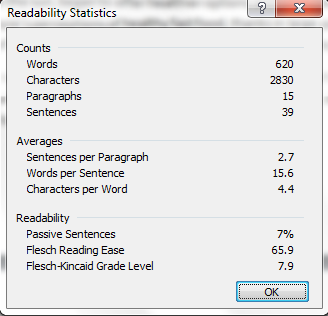 The image on the right shows you what this looks like. Setting it up in Word is easy. In Word 2010, go to:
The image on the right shows you what this looks like. Setting it up in Word is easy. In Word 2010, go to:
File >> Options >> Proofing >> Check “Show readability statistics” about 2/3 of the way down.
This will not find the passive sentences for you, but it will show you how many you have. Try for two or less per 500 words.
To get your grade level down and reading ease up, follow the rules above. Take long sentences and make them short. Take four syllable words and make them two. Take paragraphs with five or more sentences and divided them into two paragraphs.
You will be well on your way to better writing!
And in case you were wondering, this post has a grade level of 5.8, a 76.0 reading ease, and has one passive sentence. Can you find it?
No really, can you? Because I can’t.
Which of these rules do you think will impact your writing the most?
Questions?
Text me anytime at (260) 217-4619.
Or…check out some of my free reports to help you get on the right track:
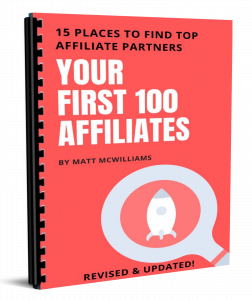 |
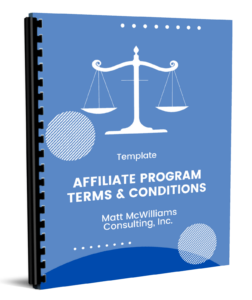 |
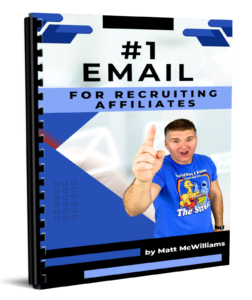 |
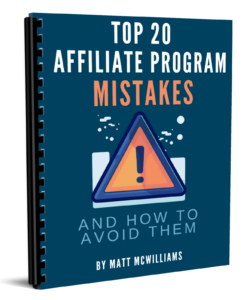 |
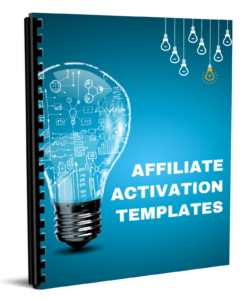 |
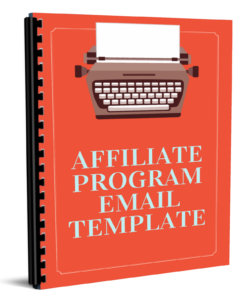 |
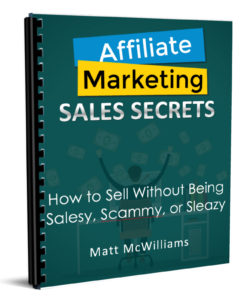 |
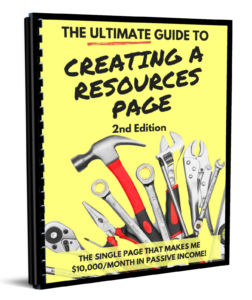 |
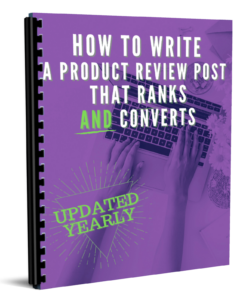 |

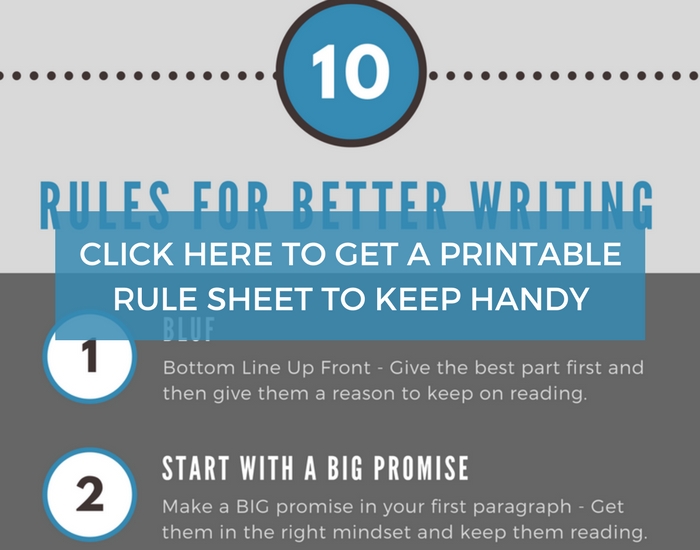








Matt, you have an excellent set of rules for writing copy, here. I especially liked your take on Don Miller’s Story framework. The only other thing Don recommends is this: Add a line about what’s at stake if you fail to take action. But even without it, rule #4 above is still a winner.
Absolutely. That’s part of the A in Ray Edwards’ PASTOR formula as well. Amplify the problem.
Quitting smoking isn’t just about feeling better. It’s about not dying in 10 years and being there for your kids.
(for example)
Great post! Love the BLUF concept and will see how I can implement that in newsletters.
As for the short sentences, I wrote that way for years in my blog. Works well – however the problem with that style is when it comes to writing a book, you want to tone that down by 99%!
My editor had a field day when I turned in the first chapter with nothing but short sentences. Yup, I wrote my book like a blog or newsletter. That taught me a lot about where and when to use the short sentences rule.
Anyway, thanks a lot for this post. I downloaded the quick reference. Very valuable.
As for the passive sentence… my guess:
“To get your grade level down and reading ease up, follow the rules above”
Sounds quite Yoda-ish to me!
Nope – not the one 🙂
HAHA!
Agreed on books. My first draft is done and it’ll need to be “bookified” a bit.
Awesome to hear! Yeah, took a while to get out of the blog mindset for me. And darn, that sentence is so passive!! Good luck on the book.
Okay, question, how do you do 1, 2, and 4 together? (Or are you even supposed to?) Because the good example you gave for telling a story looks like it would break rules 1 and 2?
Do you start with the big promise, then switch to a story? Just trying to imagine how it would all piece together in real life. Thanks!
You CAN…and you can use the power of open loops doing it!
OK, this is off the top of my head so it’s worth what you are paying for it 🙂
====
Two years ago discovered something about copywriting that absolutely blew my mind.
It’s a tool that helped me more than DOUBLE my open rates and click through rates. And it can work for you, too. [BLUF / BIG PROMISE]
I’ll tell you more about it in a moment, but first let me tell you where I was two years ago.
Two years I was ready to give up on my business…continue [STORY]
====
They actually work incredibly well together. 🙂
I didn’t even know Word had readability – very cool and checking it out.
I’m a big fan of using Hemingway app with Grammarly. Hemingway is tough on sentence length. Grammarly will catch a decent amount of passive constructions.
All the tools in the world probably won’t replace the ultimate discipline, though:
Reading your stuff out loud.
I don’t do it all the time, but when I do, the text is always improved beyond anything apart from having a pro-editor hack at something.
And even then, reading out loud is a best practice.
Thanks for the great post and cool story graphics to illustrate the journey! 🙂
Agreed. On our content calendar, reading it out loud is one of the last checks we do.
Always helpful!
A year ago, I would never find the passive sentence in the text above. [WHERE I WAS / CHARACTER]
Not to mention I couldn’t spell anything. My writing and grammar were terrible. [PROBLEM]
Now, today I write blog posts and emails every single week. I enjoy the feeling of being able to convey a message without the fear of sounding illiterate. [WHERE I AM NOW]
How’d I get to this point? Well, I’ll share more about that a moment. [OPEN LOOP]
But first, let me take you back a year ago.
That’s when I stumbled upon Grammarly. [GUIDE]
I was watching one of those Youtube videos, and for once, instead of getting another Tai Lopez ad, I saw an ad for Grammarly. [PLAN]
It looked simple enough, and it was free. So I decided to give it a try. [CALL TO ACTION]
And I did…that day I installed Grammarly on my Chrome browser and on Office.[ACTION]
And the results?
According to Grammarly’s stats, I am currently more accurate and have a larger vocabulary than 97% of Grammarly’s users! [SUCCESS]
_________________________________________________________________________________
“..your audience is compelled to buy..” is the passive sentence.
Grammarly aff link will be submitted upon request 😉
Thanks for great read!
A.
A year ago, I would never find the passive sentence in the text above. [WHERE I WAS / CHARACTER]
Not to mention I couldn’t spell anything. My writing and grammar were terrible. [PROBLEM]
Now, today I write blog posts and emails every single week. I enjoy the feeling of being able to convey a message without the fear of sounding illiterate. [WHERE I AM NOW]
How’d I get to this point? Well, I’ll share more about that a moment. [OPEN LOOP]
But first, let me take you back a year ago.
That’s when I stumbled upon Grammarly. [GUIDE]
I was watching one of those Youtube videos, and for once, instead of getting another Tai Lopez ad, I saw an ad for Grammarly. [PLAN]
It looked simple enough, and it was free. So I decided to give it a try. [CALL TO ACTION]
And I did…that day I installed Grammarly on my Chrome browser and on Office.[ACTION]
And the results?
According to Grammarly’s stats, I am currently more accurate and have a larger vocabulary than 97% of Grammarly’s users! [SUCCESS]
_________________________________________________________________________________
“..your audience is compelled to buy..” is the passive sentence.
Grammarly aff link will be submitted upon request 😉
Thanks for the great read!
A.
Is there an award for best comment ever?
Grammarly kills me though…such a resource hog. Still haven’t figured that one out. 😉
Matt, excellent tips. Especially start with a big promise. It sounds obvious, but I haven’t use the formula before. I’m going to rewrite the beggining of my recent articles!
I’ve been using Google docs for writing and can’t find the readibility tool there. But for those who don’t use Microsoft Word, there is a tool called readable.io.